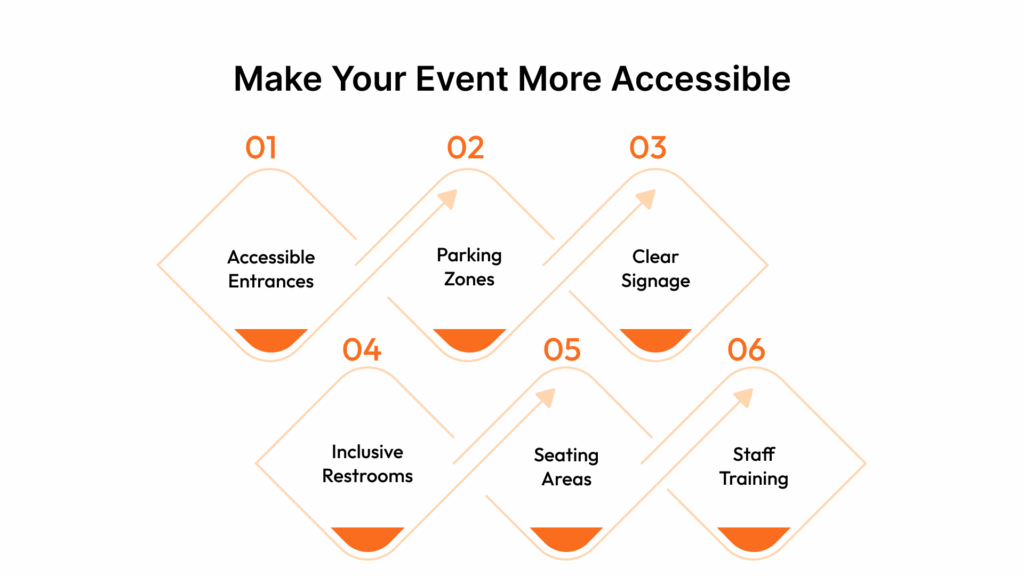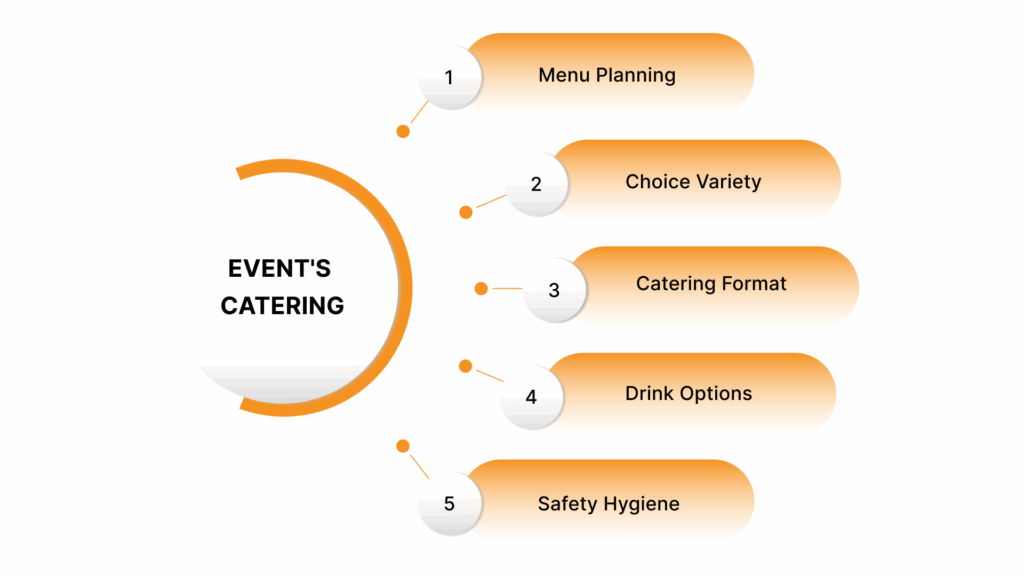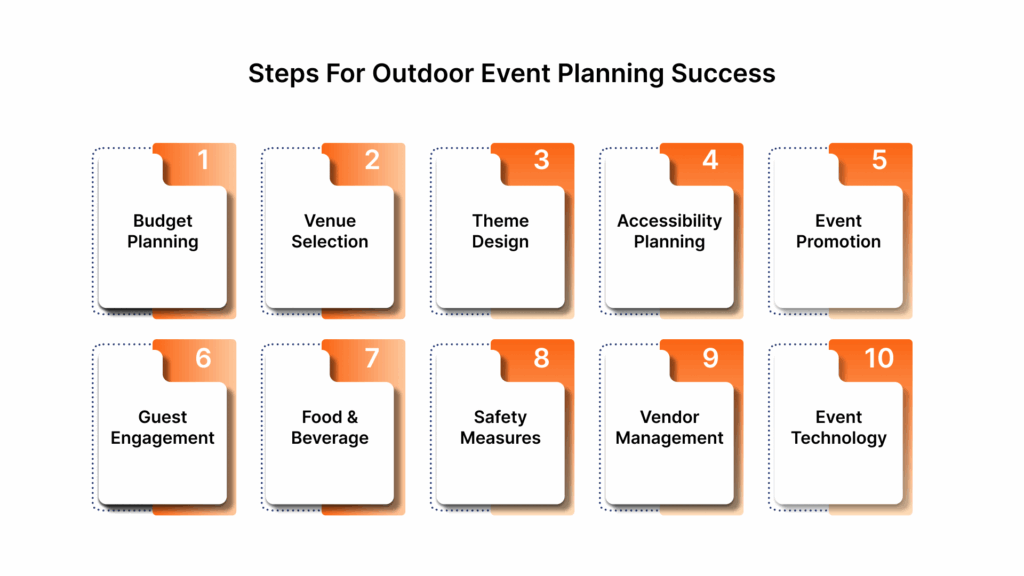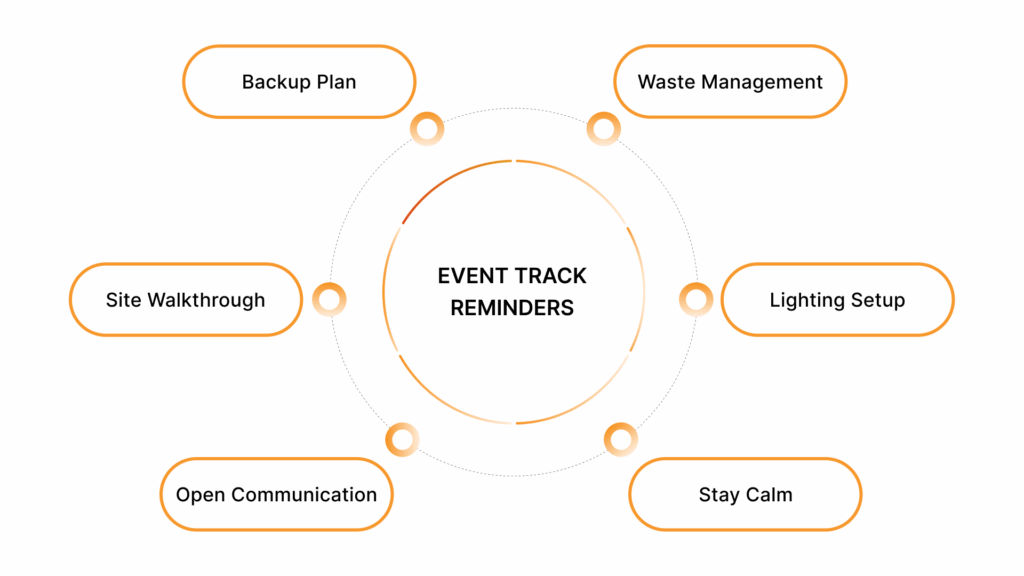Planning an outdoor event comes with a unique set of opportunities and challenges. Whether you’re organizing a community festival, a sports tournament, a cultural celebration, or a corporate gathering, the key to success lies in smart planning, agile coordination, and real-time adaptability.
With the global events industry expected to grow to $1,930.26 billion by 2029, at a CAGR of 9.4% the demand for seamless, large-scale, and technology-driven outdoor experiences is on the rise. This surge reflects a growing appetite for in-person and hybrid events that connect communities, showcase culture, and drive economic impact.
In this blog, you’ll learn 10 practical steps for outdoor event planning designed to help you stay on track and deliver a memorable experience.
TL;DR
Set a clear budget, choose a venue that fits your event goals, and plan for weather and accessibility from day one.
Use a strong theme, reliable vendors, and inclusive amenities to enhance guest experience.
Promote smartly across channels and offer engaging entertainment to keep attendees interested.
Leverage event technology platforms like Wiz-Team’s Event-Works to streamline registration, logistics, and real-time coordination.
1. Start with a clear, realistic budget
Before you pick a venue or start sending out invites, there’s one thing that needs your attention right away. Your budget. A solid financial plan defines what’s possible, what needs adjusting, and where you can afford to invest more for impact. Your budget acts as the framework that holds the entire event together.
Here’s how to approach it:
Identify your funding sources: Start by figuring out where the money is coming from, like internal funds, sponsorships, ticket sales, or grants. Clarifying this upfront will help you prioritize your spending and know how flexible your planning can be.
Break down costs by category: Divide your budget into clear sections, like venue, permits, equipment rentals, staffing, marketing, tech tools, and contingency. This makes it easier to track what you’re spending and avoid going overboard in one area.
Account for hidden and one-time costs: Outdoor events come with extras that indoor events might not, things like temporary fencing, portable toilets, weather tents, lighting towers, or ground protection. These might not be obvious at first but can take up a good chunk of your budget.
Build in a contingency buffer: Even the most detailed plan can hit unexpected bumps. Set aside at least 10–15% of your total budget for last-minute expenses or weather-related changes.
Track and adjust as you go: Keep a close eye on expenses as they happen and make adjustments where needed. Real-time tracking tools or budget templates can help you stay on course throughout the planning process.
2. Find a venue that matches your event’s needs
Once your budget is in place, the next important task is finding a location that supports your vision. The venue you choose influences logistics, crowd flow, accessibility, safety, and even the mood of the event. For outdoor gatherings, there are even more variables to consider, like weather exposure, power supply, terrain, and local regulations.
Below are some key ways to select the right venue for your event.
Match the venue to your event type: Think about what kind of experience you want to create. A food festival might need open green space for stalls and foot traffic, while a corporate gathering may require a more controlled, private setting.
Make sure the venue supports the event’s flow, purpose, and expected number of guests.
Check for essential infrastructure: Look beyond aesthetics. Does the location offer access to water, electricity, waste disposal, restrooms, or internet connectivity? These basics can dramatically affect both your planning and your costs.
Understand the permit and legal requirements: Outdoor venues, especially public spaces, often require permissions from local authorities. Find out what’s needed early on, whether it’s a noise permit, insurance coverage, food vendor approval, or crowd control measures.
Assess accessibility for all guests: The venue should be easy to reach, whether by public transport or private vehicles. It should also be accessible for people with disabilities.
Factor in emergency access and exits: Safety is a top priority, especially in open environments. Make sure the venue has clearly marked exits, space for emergency vehicles, and clear paths for evacuation if needed.
Consider the weather and natural surroundings
Before finalizing a venue, take time to study the location’s typical weather patterns during your event date. Preparing for the environment also means thinking about comfort. For hot days, you might need cooling stations or extra hydration points. For colder evenings, you may want to provide blankets or outdoor heaters.
The more you understand the natural setting and climate, the easier it will be to create a space that’s both functional and welcoming for your team, your vendors, and most importantly, your attendees.
3. Set the mood with a theme and purposeful decor
After sorting out your budget and venue, it’s time to think about how your event will feel. The overall look, tone, and atmosphere of your event start with a well-chosen theme. Whether you’re aiming for something elegant, casual, festive, or innovative, your theme brings everything together, from the signage and stage design to lighting and table settings.
A strong theme is about consistency, clarity, and creating an environment that resonates with your audience. And in outdoor settings, your décor should work well with natural surroundings and weather conditions, too.
4. Make sure everyone can get in and move around easily
One of the most important things you can do when planning an outdoor event is to make sure it’s easy for everyone to attend and move through the space comfortably. Accessibility is about showing that you’ve thought about every guest, including those with mobility challenges, visual or hearing impairments, or other special needs.
Here’s how to make your event more accessible.

Plan for accessible entry and exit points: Ensure the main entrances and exits are wide enough for wheelchairs and walkers. Avoid steep slopes or uneven ground at these points. If needed, add ramps or temporary pathways that meet basic accessibility standards.
Provide accessible parking and drop-off zones: If your venue includes parking, reserve clearly marked spots close to the entrance for those with disabilities. Also, set up a designated drop-off point for guests who may need assistance getting to the event area.
Use clear, easy-to-read signage: All your signs, whether they direct people to restrooms, help desks, or emergency exits, should be easy to read from a distance. Use large fonts, high-contrast colors, and simple language.
Ensure restrooms are inclusive: Make sure at least one accessible restroom is available and easy to reach from the main event area. It should be well-lit, clean, and properly marked. Consider adding gender-neutral options as well.
Offer seating and rest areas: Set up rest zones with benches or chairs at different points across the venue, especially if there’s a lot of walking involved.
Train your event staff to be aware and helpful: Make sure your volunteers and staff understand how to assist attendees with different needs.
5. Spread the word and build excitement
You’ve set the stage, but now it’s time to fill it. No matter how well-organized your event is, it won’t reach its full potential unless people know about it and feel motivated to attend. That’s where smart, timely promotion comes in.
In a 2024 global survey, 83% of marketers said increased exposure was the biggest benefit of using social media for promotion. That makes platforms like Instagram, LinkedIn, and Facebook essential tools for getting your event in front of the right people.
Here’s how to get your message out effectively.
Know your audience: Start by identifying who your event is meant for. Your messaging should speak their language and focus on what they’ll gain from attending, fun, learning, networking, entertainment, or something else.
Use the right mix of channels: Combine digital channels like Instagram, LinkedIn, or WhatsApp with offline tools like posters, community boards, or radio, depending on where your target audience is most active.
Keep the message clear and simple: When promoting, don’t overcomplicate. Share the basics and highlight any special guests, entertainment, free perks, or causes the event supports.
Create a sense of urgency: Encourage early sign-ups or ticket purchases by offering early-bird rates or limited-time discounts. Countdown timers, limited space alerts, or reminders of closing registration dates help drive action.
Let your visuals do the talking: Use clean, attractive visuals that align with your event’s theme. Strong imagery can often say more than long captions. Make sure your graphics are mobile-friendly and consistent across platforms.
Involve partners and sponsors: If your event has sponsors, partners, or collaborators, ask them to help share your message. Provide them with pre-made content like social posts, email templates, or banners they can use on their own platforms.
6. Keep guests engaged with the right mix of fun and interaction
An outdoor event is about the experience you create for the people attending. Whether it’s a cultural fair or sporting event, what keeps guests talking (and coming back) is how engaged and entertained they feel.
Entertainment and activities are a vital part of the atmosphere. From live music and games to interactive booths or wellness corners, these elements bring your event to life.
Here’s how to plan activities and entertainment that leave a lasting impression.
Understand what your audience enjoys: Before you book a band or set up a photo booth, think about who’s attending. A family-oriented community day may benefit from kid-friendly games, while a business retreat might be better suited to team-building exercises or laid-back live music.
Use the space to your advantage: Outdoor venues often give you more flexibility. Spread out the activity areas so they don’t overlap or compete.
Keep things moving: Avoid long gaps in your schedule. Plan activities with overlapping start times and quick transitions to maintain energy throughout the day. Publish a simple, easy-to-follow agenda so guests know what’s happening and when.
Offer something unexpected: People remember surprises. Think of small, creative touches, like a pop-up art wall, a surprise guest performance, or a DIY corner.
7. Get food and drinks right for a better guest experience
Food might not be the first thing you plan, but it’s one of the first things guests will remember. At any outdoor event, the quality, variety, and availability of food and drink can directly shape how people feel about their experience.
Whether you’re offering full meals, light snacks, or mobile food trucks, the key is to plan early, think practically, and prioritize crowd flow and guest comfort.
Here’s how to get your event’s catering right:

Menu planning: Start by understanding who you’re feeding. Your menu should reflect your audience’s needs, offering options like comfort food, health-conscious meals, or grab-and-go snacks depending on the crowd.
Offer a range of choices: Include vegetarian, vegan, and gluten-free options wherever possible. Not only is this more inclusive, but it also saves you from scrambling if guests have dietary restrictions.
Choose the right catering format: You don’t have to go with a formal buffet. For outdoor events, food trucks, food stalls, or pre-packed boxes can make service faster and smoother.
Plan for drinks and hydration: Don’t overlook beverages. Offer a mix of water stations, soft drinks, and tea/coffee.
Focus on safety and hygiene: Outdoor setups require more attention to cleanliness. Make sure your caterers follow food safety rules. Have hand-sanitizing stations nearby, and ensure food is covered, stored properly, and kept at the right temperature.
8. Put guest safety and wellbeing first
When planning an outdoor event, safety should never be an afterthought. Making sure your attendees feel secure is just as important as entertaining them. Outdoor events come with their own set of risks, uneven ground, changing weather, electrical setups, large crowds, and sometimes unpredictable environments.
Your job is to spot the potential issues early and put the right systems in place to prevent them. Beyond physical safety, it’s also about creating an environment where people feel comfortable, cared for, and able to enjoy the experience without worry.
9. Work with vendors you can count on
Behind every smooth-running outdoor event is a team of dependable vendors and suppliers. From tents and lighting to sound systems, portable toilets, staging, catering, and cleanup, your vendors play a huge role in how your event comes together.
In outdoor settings, where conditions can change quickly and setup timelines are tight, you can’t afford to work with unreliable providers. Choosing partners who are experienced, communicative, and flexible gives you one less thing to worry about on event day. It also helps you avoid last-minute delays, equipment failure, or poor service that can affect the guest experience.
10. Use the right technology to keep everything running smoothly
Technology is a core part of making everything work on the ground. From managing check-ins to tracking crowd flow, event technology tools help you stay organized, respond quickly to issues, and give attendees a better overall experience.
With the right digital tools in place, your team can cut down on manual tasks, fix problems as they come up, and keep things moving without delays. Here’s how to make technology work for you during your outdoor event.
Use mobile check-in and registration systems: Say goodbye to printed lists and long wait times. With mobile check-in tools, guests can register and enter quickly, while your staff gets real-time updates on attendance.
Monitor guest flow in real time: Use digital dashboards to keep an eye on where people are gathering, moving, or facing issues. This helps with crowd management and allows for faster decisions.
Send timely updates and alerts: Whether it’s a weather warning or a schedule change, real-time notifications (via SMS or push alerts) help you reach your staff and even attendees immediately.
Offer self-service options for guests: Digital kiosks or mobile apps make it easy for attendees to check schedules, find session locations, or get answers to common questions without constantly approaching event staff.
Use a centralized tech platform
Instead of juggling multiple tools, go with a unified platform that keeps everything, from registration and accreditation to access control and guest communications, in one place. Wiz-Team’s Event-Works is a strong example. It’s a modular, cloud-based event management solution built specifically for complex, large-scale events, offering tools that support real-time coordination, on-site operations, and seamless data management.
Helpful reminders to keep your outdoor event on track
Even with the best planning, outdoor events come with their fair share of unpredictability, like weather shifts, last-minute guest changes, tech hiccups, or delivery delays. The key to success lies in being prepared, staying calm, and knowing how to adapt when the unexpected happens.
Here are some simple tips to help you stay one step ahead.
Have a backup plan for everything
Rain, wind, or power issues, things can change fast outdoors. Always have a backup plan for key areas like seating, food service, staging, and tech setups.
Walk through the site before the event
Take a final walk through the space a day or two before setup. Look for anything you might’ve missed, like loose cables, uneven ground, or traffic flow issues. It helps you catch and fix small problems before they become bigger ones.
Keep communication lines open
On event day, everyone, from staff to vendors to volunteers, should know who to talk to and how to reach them quickly. A simple group chat or command center setup can go a long way in avoiding confusion or delays.
Prepare for waste and clean-up
Outdoor events generate a lot of trash, cups, plates, wrappers, signage, and more. Set up plenty of clearly marked bins and schedule a cleanup team for during and after the event.
Don’t overlook lighting
If your event runs into the evening, make sure there’s enough lighting, not just for ambiance, but also for safety. Well-lit walkways, entrances, and exits help people navigate comfortably and reduce risk of accidents.
Stay calm and be flexible
Keep your core team steady, stay positive, and remember, guests won’t remember the small hiccups if everything else feels well-run and welcoming.
Conclusion
Outdoor events come with unique challenges, but smart planning, the right partners, and attention to detail can make all the difference. From securing vendors to managing onsite logistics, every step adds up to a smoother, more enjoyable experience.
Technology plays a key role in tying it all together. With the right tools, you can stay organized, adapt quickly, and deliver a standout event. Wiz Team’s all-in-one platform, Event-Works, is built to handle the complexities of outdoor events.
Looking to simplify your next outdoor event? Explore how Wiz-Team’s Event-Works platform can help you manage every detail, from registration to real-time logistics.
FAQS
How to plan an outdoor event?
Start by defining your event’s purpose and goals, then choose a suitable location, create a budget, and develop a timeline. Consider logistics like permits, equipment, and weather contingencies to ensure a smooth execution.
What are the 5 P’s of event planning?
The 5 P’s of event planning are: Purpose (the reason for the event), People (the target audience), Place (the venue), Promotion (how to market the event), and Price (the budget and ticketing strategy).
What are the 7 stages for event planning?
The 7 stages of event planning include: Research, Design, Planning, Coordination, Execution, Evaluation, and Follow-up. Each stage is crucial for ensuring the event meets its objectives and provides a positive experience.
How do I choose the right venue for my outdoor event?
Consider factors like location accessibility, capacity, amenities, and the overall atmosphere. Visit potential venues to assess their suitability and ensure they align with your event’s theme and goals.
What permits do I need for an outdoor event?
Depending on your location, you may need permits for gatherings, food service, alcohol sales, and noise regulations. Check with local authorities to ensure compliance with all legal requirements.
How can I effectively promote my outdoor event?
Utilize social media, email marketing, and local partnerships to reach your target audience. Create engaging content and consider early bird discounts to encourage ticket sales.
#WizJourney











